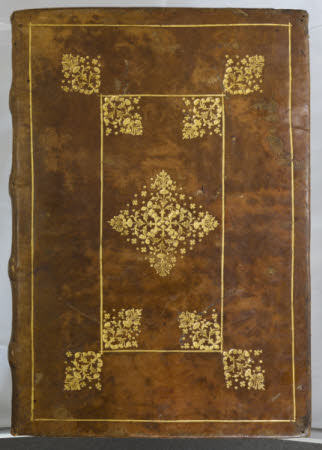Ab rhodo quo p[er]tenderat ... insequentiu[m] principu[m]. Caesa[rum] lib[er] xii explicit.
Suetonius (c.69-c.122)
Category
Manuscripts and documents
Date
1452
Materials
Measurements
308 x 218 x 46 mm
Place of origin
Ferrara
Order this imageCollection
Blickling Hall, Norfolk
NT 3130728
Summary
Manuscript. Written in Italy (probably Ferrara). Partly illuminated by Marco dell'Avogaro in pioneering classical style. Upright humanistic script, apparently that of Johannes de Maguntia [John of Mainz] and probably the manuscript for which Borso d'Este owed 4 gold ducats in 1452. 300 x 210 mm. Written space 175 x 110mm. 27 long lines.
Full description
The recovery of the Greek and Roman classics in the fifteenth century was not based merely on a scholarly interest in literature of the past. Cicero on rhetoric, Vegetius on fortification, Strabo and Ptolemy on cosmography and geography, were read as practical treatises: better knowledge of how to make a speech, of military engineering, or of the surface of the earth and structure of the universe, could give you an edge on your rivals or enemies. History, too, had a practical purpose: the past could teach you how to deal with the present. It was in this belief that scholars ransacked the libraries in old and out-of-the-way monasteries, and princes and potentates commissioned handsome illuminated copies of the texts that they found. Suetonius (c.69-c.122), in writing the lives of the first twelve Roman emperors, had access to first-hand knowledge of the events that he described; he also knew all the contemporary gossip – the more scandalous the better. Both made his work popular in the Renaissance. The Roman empire had been vast, and much might be learned about ruling from the public careers of the emperors; the more shocking details of their private lives both titillated and satisfied a moral sense of superiority. There are many 15th-century manuscripts known; some, like this, are elaborately decorated. This copy was written and painted for Borso d’Este (1413–71), Duke of Modena, Reggio and Ferrara in 1452–53, soon after he had succeeded his father, Lionello d’Este. The very fine script is in the hand of 'Johannes de Maguntia' (John of Mainz), the court scribe, who later moved from the court of Ferrara to Cesena, where he did work for Malatesta Novello. He was paid 4 'ducati d’oro' for the writing in 1452. The decoration, the initials combining elaborate 'bianchi girari' (white vine scrolls) with the d’Este arms and the profile portraits of the emperors in the style of antique cameos, each in an elaborate frame, was the responsibility of the Ferrarese court book-painter, Marco d’Avogaro, who received payments for it with other work in 1452 and 1453. Both scribe and painter produced other classical texts for Borso, including manuscripts of Juvenal and Livy. This manuscript later passed into the famous collection of Queen Christina of Sweden before 1655 when it was marked by her librarian, Isaac Voss. The Queen was not punctual in paying his wages, and he retaliated by removing books from the collection. This may explain why it also bears the signature of the Dutch diplomat and classical scholar, Nicholas Heinsius (1620–81). It is probable that the book was acquired by Sir Richard Ellys in Holland.
Bibliographic description
[iv, 176, iii] leaves : ill., ports. ; 31 cm. (fol.) Running number: 6917. Leaf iv vellum, somewhat worm damaged and repaired with paper. Wanting four leaves: first leaf (1 1) containing beginning of life of Julius Caesar, leaf (5 8) containing final part of life of Augustus and beginning of life of Tiberius, leaf (18 1) containing text from life of Domitian, and final leaf (18 10) probably containing indexes and rubrics or a blank. Provenance: coat of arms of the Este family on f. 23v; probably written for Borso d'Este (1413-1471), Duke of Ferrara, Modena and Reggio [probably no. 29 in the Este catalogue of 1467 printed by G. Bertoni 'La biblioteca estense', 1903, p. 216]. Inscription on leaf iv recto: "Caius Suetonius De vitis duodecim Caesarum. Volumen CCV. non Petavianus" [i.e. marked as a non-Petau manuscript from the library of Queen Christina of Sweden (1626-1689), written by her librarian Isaac Vossius (1618-1689)]. Inscription on f. 1 recto: "Nicolai Heinsii' [i.e. Nicolaas Heinsius (1620-1681), Dutch classical scholar, poet and diplomat]. Isaac Vossius and Nicolaas Heinsius procured books for Queen Christina on their travels around Europe. After Christina's abdication in 1654, Vossius accompanied her to Antwerp and Brussels where, in lieu of his and Heinsius' unpaid wages, he was allowed to take books and manuscripts from her library. Heinsius' library was sold in March 1683. Library of Sir Richard Ellys (1682-1742) of Nocton, Lincolnshire; probably acquired by him in the Netherlands. Inscription on front pastedown: "Library Blickling CH Suffield" [i.e. Caroline Harbord, Lady Suffield (1767-1850)]. Various fifteenth, sixteenth or seventeenth-century inscriptions and numbers on leaf iv, very faint and mostly illegible, but including "X" (in red crayon) "307" (in black ink), "... no. 33 cartar[?]. 168" (in black ink), and "157" (in thick lead-drawn numbers). Nineteenth or twentieth-century reference number in pencil on front free endpaper: "B38". Binding: seventeenth-century full gold-tooled calf over boards; sewn on four supports; single gilt fillet outer and inner panel, the inner panel with gilt centrepiece, cornerpieces and anglepieces of floral, quatrefoil and small star tools; gold-tooled spine with fillet, floral roll and stamp decoration; gilt edges. Some worm holes in boards and endpapers. In modern brown buckram book box. The original binding was 'Braxilio rubeo cum quinque Brochis magnis super unaque alba et quattuor azuliis deauratis' (no. 29 in Bertoni's Este catalogue of 1467).
Makers and roles
Suetonius (c.69-c.122), author Johannes, de Maguntia, scribe Marco, dell'Avogaro (fl. 1449-1476), illuminator
References
100 Books from the Libraries of the National Trust 2023 Barker, Nicolas. Treasures from the libraries of National Trust country houses. 1999., cat. 5, pp.50–1.


